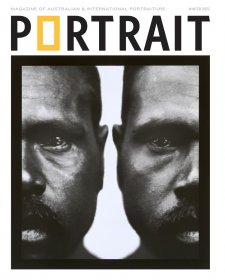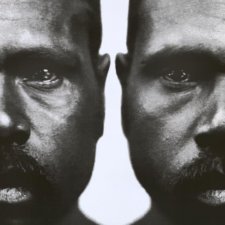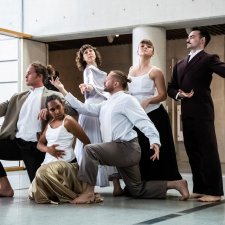The first time Neale Daniher AO and his family saw Michael Peck’s portrait Play on (A portrait of Neale Daniher) they were blown away by how realistic and dignified it was, and how honest in its portrayal of Daniher’s fight against Motor Neuron Disease (MND).
Commissioned by the National Portrait Gallery in 2021, the artist and Daniher were clear from the very beginning that his battle with MND would be the focus of the portrait. In Daniher’s 2019 memoir, which he gave to Peck at their first meeting, he wrote that in order to confront and fight the disease he would need to be able to envision it: ‘MND sounded too innocuous, too clinical. So I called it The Beast.
An ugly piece of gear, hairy and dark, like a huge hybrid of a blowfly and a moth. I wasn’t sure how, but I was going to take the fight right up to it.’ The Beast is presented as a grotesque and deformed insect mounted on a taxidermist pin in the foreground of the painting, drawing the viewer in. Peck noted that it was the last, and most difficult, part of the portrait commission. ‘Neale and I discussed this and on seeing the [earlier] image his only request was that I make it uglier!’
Daniher first came to public attention after being signed by the Essendon Football Club in 1979. He went on to have a remarkable career as an AFL player, playing 82 games for the club over ten seasons. As head coach for the Melbourne Football Club, he guided the Demons to the grand final against his old side Essendon in 2000. He was later general manager of football operations at the West Coast Eagles until his retirement in 2013, when he was diagnosed with MND. Daniher made his diagnosis public the following year, co-establishing the FightMND organisation with Pat Cunningham to raise awareness and funds for medical research into the disease. Their signature event, The Big Freeze – held during the annual Queen’s Birthday match between Melbourne and Collingwood at the Melbourne Cricket Ground – unites AFL teams, fans and the broader community in the fight against MND.
Painted in muted sepia tones – Peck didn’t want colour or team affiliations to distract from his sitter’s character and fighting spirit – Play on is grand in scale and rich in its use of symbolism. Each element of the work is carefully rendered and highly considered, highlighting the importance of the relationship that developed between artist and sitter. Revealing elements of Daniher’s strength and his impact as a crusader for research into MND, the portrait depicts him seated at a table, looking towards the viewer with a determined gaze.
The physical changes MND has brought to Daniher are immediately obvious. A degenerative condition, MND takes away the use of a patient’s arms and legs, affects their speech and later, their ability to swallow and breathe. It was important to both the artist and sitter that the portrait would illustrate the reality of the disease.
In sittings Daniher purposely sat with his hands propped on a table in a pose that makes the changes to his body noticeable. ‘It was not comfortable for Neale to sit like this,’ Peck says, ‘but he was determined to capture the right image. This alone is testament to his strength and determination.’
Part of this determination was the establishment of FightMND and in a nod to this achievement, Peck depicted Daniher wearing the Big Freeze beanie. ‘Each year when these beanies are made available, they sell out immediately,’ says Peck, ‘and Melburnians wear them proudly in support of Neale and the FightMND organisation.’
Celebrating an indomitable and generous spirit, this portrait is a fitting tribute to Daniher’s tireless work to bring public attention and research funding to MND, and his determination to help prevent the suffering of those who may be diagnosed with this disease in the future.

















